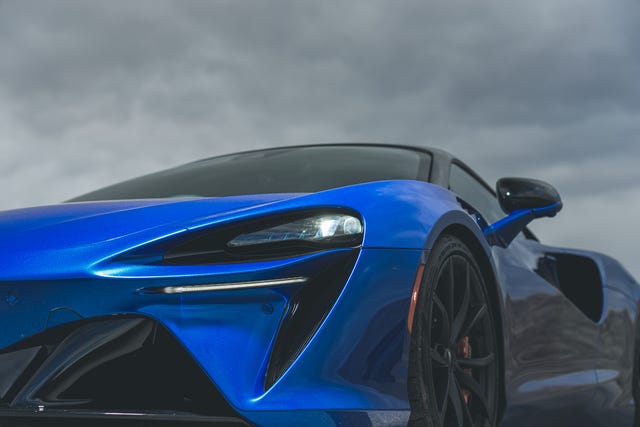Tested: 2023 McLaren Artura Is the Second Coming

From the April 2023 issue of Car and Driver.
It’s hard to believe McLaren has been in the road-car game for little more than a decade. (Granted, it was nearly 30 years ago that the McLaren F1 became the be-all and end-all for enthusiasts, but McLaren didn’t produce another street car for years afterward.) Since 2011, the storied Formula 1 brand has launched several root models and completely upset the supercar hierarchy that a pair of Italian companies had long dominated. And while all of those models, including the MP4-12C, the 570S, the Senna, and the 720S, have their own character, they’ve all shared a very similar set of components. The Artura is new, and not like your favorite streaming service’s latest round of reboots. New as in never before. Think Severance, not Bel-Air. For all intents, it is McLaren’s second series-production car. And it’s a plug-in hybrid.
The Artura’s 181-pound carbon-fiber tub looks a lot like the old one manufactured by Carbo Tech in Austria, only it’s stronger and lighter and has a cavity that incorporates the audio system’s subwoofer. It’s also now made in-house at McLaren’s carbon-fiber factory in Sheffield, England. The engine, a 120-degree 577-hp twin-turbocharged 3.0-liter V-6, is more of a departure. All McLarens before (except the F1, with its BMW V-12) used a V-8 displacing 3.8 or 4.0 liters. Compared with the V-8, this new V-6 is about 110 pounds lighter and shockingly small. Like “I didn’t know the original Mini was that small” small. The eight-speed dual-clutch transaxle is about the same size as the old seven-speed, thanks in part to its lack of a reverse geartrain, but it now incorporates McLaren’s first application of an electronically controlled limited-slip differential. All reversing is strictly electric, provided by the motor, a 94-hp axial-flux unit, spinning backward. The motor is just upstream of the transmission input. It’s a power-dense ring that a drunk Ultimate Frisbee player would attempt to discus toss should one be unguarded at closing time. The front suspension still uses control arms, but the rear is now a multilink design said to improve stiffness and reduce deflection. There’s no hydropneumatic suspension here; it’s coil springs and anti-roll bars just like in the GT that sits below the Artura in the lineup.
Car and Driver
That’s a lot of time spent telling you about the new hardware. But it seems worthwhile because this car launch almost broke the company. McLaren is arguably the smallest, least supported supercar manufacturer selling federalized cars, and rumors of receivership swirled when the Woking-based brand leveraged its lustworthy fleet of historic racers to pay for the expensive development of a new electrical architecture and plug-in-hybrid engineering. Remember, Lamborghini and Porsche have the Volkswagen Group’s deep pockets, and Ferrari, which has been building street cars for more than 70 years, had Fiat backing until fairly recently.
HIGHS: Solid rocket-booster acceleration, all-day comfort, beautiful exterior.
We are happy to tell you that despite the apparent engineering and financing trouble, the product is worth the wait. Its silhouette is pure speed, like that of a falcon in a 200-mph dive. We were worried that the added mass of a motor (which turned out to be a heavy plate) and the 7.4-kWh lithium-ion battery would ruin the McLaren feel we’re accustomed to. But at 3443 pounds, the car is lighter than a Corvette Z06 and very likely lighter than the Ferrari 296GTB (we’ll know for sure when we test one). The extra weight is so low in the car—and the engine sits entirely below the top of the wheels—it seemingly anchors the Artura to the road.
On a flat proving-ground skidpad, the Pirelli P Zero Corsa PZC4 tires stick at 1.08 g’s, and 1.07 are usable on the open road. Turn-in is crisp, and feel—from an electrohydraulic assist—is the best in the business. Resistance builds naturally, then tapers off just before understeer arrives. The chassis balance is much more benign than in the tail-happy 570S, but still far from boring. It safely pegs the public-road fun meter in the red.
This is a good thing because the car can generate extralegal speed in extra-short time. Hitting 60 mph in 2.6 seconds may be Z06 territory, but the McLaren walks away from the American at higher speeds, reaching 100 mph in 5.5 seconds and completing the quarter-mile in 10.3 seconds at 140 mph. Even the similarly priced Porsche 911 Turbo S Lightweight, which beats the McLaren to 60 and in the quarter (danke, all-wheel-drive traction), is a second slower to reach 180 mph. A 720S is much quicker, but the soon-to-be-replaced 720S also starts some $73,000 higher than the $237,500 Artura. This Volcano Blue example stickers for $284,925, and the vast majority of the options are aesthetic, not functional.

Marc Urbano|Car and Driver
LOWS: No more V-8 feels, could be more playful at the limit, and, you know, the price.
We didn’t do an official range test of the hybrid system, but we successfully drove the Artura in EV mode for 13.5 miles. About five of those miles were on a 55-mph road, and the remainder were on the highway, very near EV mode’s 81-mph top speed. The motor couldn’t maintain that speed on steep grades. Even so we didn’t need to wake the V-6 on the freeway. The EPA electric-only range of 11 miles is very achievable. On the rest of our drive, we averaged 18 mpg, matching the EPA combined estimate.
Rocker switches on the instrument binnacle are a close reach from the steering wheel and provide the ability to change the various powertrain modes (Electric, Comfort, Sport, Track) and chassis modes (Comfort, Sport, Track). The wheel and binnacle move in concert when adjusting for rake and reach. Like Ferrari, McLaren doesn’t want drivers to take their hands off the wheel any more than necessary. Unlike Ferrari, McLaren’s answer wasn’t to put more buttons on the wheel than a BlackBerry has keys. McLaren’s steering wheel is all but unchanged and still devoid of switches, knobs, or toggles. Mash the center for the horn.
When left in the Comfort powertrain mode and asked for more thrust than the motor can offer, the Artura occasionally pauses before firing the engine, as if to ask, “Do you really want ketchup on your hot dog?” The slow compliance serves as a sort-of eye roll. Sport mode keeps the engine on and is a great midpoint. Same goes for the chassis modes, but in the other direction; Track feels overdamped on anything but glasslike tarmac. Sport-Sport is the hot setup.
The Artura uses no regenerative braking, and the brake booster is a vacuum type (albeit powered by an electric pump), so the feel is very familiar. Stops from 70 mph take 141 feet, and from 100 they require 279 feet—good, but not great. McLaren programs the motor to induce a relatively small drag torque and recoup energy from the engine, except when you floor it. You can ask the car to charge itself faster, and Sport and Track modes always keep the battery sufficiently juiced to deliver peak performance. Driver-requested recharging using the engine isn’t very efficient, but it gives owners the ability to manage the state of charge while on the move.
About the only thing we don’t love is the new V-6. It goes like hell, but a V-6, even one with an 8200-rpm redline, can’t make the same sounds as a flat-plane-crank V-8. The Artura has an exhaust system that is silent. McLaren calls it a chimney. Radiator fans move air over the turbos in the valley of the V. Look in the rearview and heat waves distort everything behind you. While the chimney never makes a sound, the visual distortion it creates sends a message to the driver that what is ahead is what matters, and what’s ahead are more hybridized supercars. We can’t wait for the next one.

Car and Driver
Counterpoint
All frustrations about getting into the steep gas-station driveway evaporate as I am called “fierce” by a cool teenager and “fabulous” by a grizzled biker in immediate succession. That I can’t exit the vehicle over the massive carbon door sill is unimportant. Who needs to get out of a car when you look so good in it? This is the Artura in a nutshell. Small imperfections are forgotten amid an overall sense of glamour and speed. The move from motor to engine needs tuning, because the car surges at low speed. So stay at high speed—putting the pedal down turns the scenery to ribbons. Go fast, fierce, and fabulous. —Elana Scherr
Any bench-racing critics suggesting the Artura is only marginally quicker than a Corvette Z06 are looking at it wrong, akin to saying Usain Bolt wouldn’t be that far ahead of you in a footrace after the first 10 feet. The Artura and the Z06 are in a dead heat to 70 mph, but then it’s all McLaren, which is traveling 9 mph faster at the quarter-mile and gets to 170 mph a massive 8.8 seconds sooner, needing 0.4 mile less runway to do so. To the one pinning the pedal, the difference is breathtaking. —Dave VanderWerp
Arrow pointing downArrow pointing down
Specifications
Specifications
2023 McLaren Artura
Vehicle Type: mid-engine, mid-motor, rear-wheel-drive, 2-passenger, 2-door coupe
PRICE
Base/As Tested: $237,500/$284,925
Options: Volcano Blue paint, $9500; Performance Spec, $9400; Technology package, $7400; Dark Stealth Diamond Cut wheel finish, $7150; sport exhaust, $6850; Black package, $3125; McLaren Orange brake calipers, $2200; Gloss Black interior package, $1600; warning triangle and first-aid kit, $200
POWERTRAIN
Twin-turbocharged and intercooled DOHC 24-valve 3.0-liter V-6, 577 hp, 431 lb-ft + AC motor, 94 hp, 166 lb-ft (combined output: 671 hp, 531 lb-ft; 7.4-kWh lithium-ion battery pack; 3.3-kW onboard charger)
Transmission: 8-speed dual-clutch automatic
CHASSIS
Suspension, F/R: control arms/multilink
Brakes, F/R: 15.4-in vented, cross-drilled carbon-ceramic disc/15.0-in vented, cross-drilled carbon-ceramic disc
Tires: Pirelli P Zero Corsa PZC4
F: 235/35ZR-19 (91Y) Extra Load MC-C
R: 295/35ZR-20 (105Y) Extra Load MC-C
DIMENSIONS
Wheelbase: 103.9 in
Length: 178.7 in
Width: 75.3 in
Height: 47.0 in
Passenger Volume: 50 ft3
Trunk Volume: 5 ft3
Curb Weight: 3443 lb
C/D TEST RESULTS
60 mph: 2.6 sec
100 mph: 5.5 sec
130 mph: 8.8 sec
1/4-Mile: 10.3 sec @ 140 mph
150 mph: 11.8 sec
170 mph: 16.1 sec
Results above omit 1-ft rollout of 0.2 sec.
Rolling Start, 5–60 mph: 3.2 sec
Top Gear, 30–50 mph: 2.0 sec
Top Gear, 50–70 mph: 2.6 sec
Top Speed (mfr’s claim): 205 mph
Braking, 70–0 mph: 141 ft
Braking, 100–0 mph: 279 ft
Roadholding, 300-ft Skidpad: 1.08 g
C/D FUEL ECONOMY
Observed: 18 MPGe
EPA FUEL ECONOMY
Combined/City/Highway: 18/17/21 mpg
Combined Gasoline + Electricity: 39 MPGe
EV Range: 11 mi
C/D TESTING EXPLAINED

Executive Editor
K.C. Colwell is Car and Driver’s executive editor, who covers new cars and technology with a keen eye for automotive nonsense and with what he considers to be great car sense, which is a humblebrag. On his first day at C/D in 2004, he was given the keys to a Porsche 911 by someone who didn’t even know if he had a driver’s license. He also is one of the drivers who set fast laps at C/D’s annual Lightning Lap track test.





